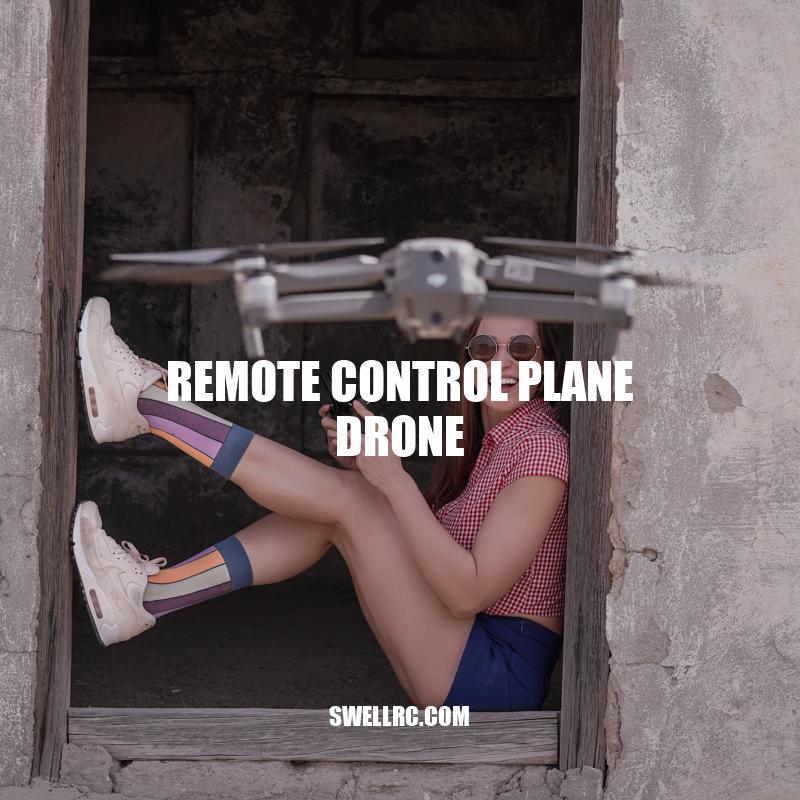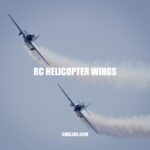Exploring the Uses and Future of Remote Control Drone Technology
Remote control plane drones are an increasingly popular technology that is being utilized by a variety of different industries. A remote control plane drone, also known as an unmanned aerial vehicle (UAV) or quadcopter, is essentially a flying robot that can be controlled from the ground using a remote controller. The technology behind remote control plane drones can vary, but most drones are made up of a few main components: the frame, motors, propellers, and controller. Some drones also come equipped with advanced features like GPS systems, cameras, and sensors. The growing popularity of remote control plane drones can be attributed in part to their versatility: they can be used for recreational purposes, in commercial applications, and even in military contexts. However, as drones become more widespread, safety concerns have arisen and regulations have been put in place to ensure their safe operation. In the following paragraphs, we will delve deeper into the workings of remote control plane drones and explore their various uses, benefits, and risks.
Remote control plane drones are made up of several different components, each of which plays a key role in the drone’s operation:
- The frame: this is the main body of the drone, which houses all the other components.
- The motors: these provide the drone with the power it needs to take off and fly.
- The propellers: these create the lift and thrust that enables the drone to move in various directions. Most drones have four propellers, hence the name “quadcopter.”
- The controller: this enables the operator to control the drone’s movements by adjusting the speed and direction of the rotors.
- The battery: this powers the drone’s motors, enabling it to fly for a certain amount of time before needing to be recharged.
While the basic mechanics of remote control plane drones are relatively simple, many drones come equipped with advanced features that make them more versatile and easier to control. For example, some drones have built-in GPS systems that enable them to fly autonomously, while others are equipped with cameras that can capture high-quality aerial footage. Additionally, many drones can be operated via smartphone apps or specialized controllers, which provide users with an intuitive interface for controlling the drone’s movements.
DJI Mavic Air 2 is a popular drone that can fly up to 34 minutes and can be controlled up to 6.2 miles away from the operator. Parrot Bebop 2 is another drone that can fly up to 25 minutes and can be controlled up to 1.2 miles away from the operator. For those who are just starting out, the Holy Stone HS100D is an affordable option at $209, with a maximum flight time of 15 minutes and a maximum control range of 500 meters.
Whether you’re a hobbyist or a professional, there are many different options when it comes to remote control plane drones. In the following paragraphs, we will explore some of the popular ways that people are using drones for both recreational and commercial purposes.
Are remote control airplanes drones?
No, remote control airplanes are not the same as drones. Drones are small, unmanned aircraft built using sophisticated technology, while remote control airplanes are made from flimsy materials like foam and are remotely piloted by an operator on the ground using a handheld radio transmitter. For more information on radio control, check out the Wikipedia page on radio control. For information on radio-controlled aircraft, check out the Wikipedia page on radio-controlled aircraft.
Remote control plane drones are becoming increasingly popular for recreational purposes, due in part to their ability to capture stunning aerial images and videos. Here are some of the ways in which people are using these drones for fun:
- Drone racing: Many people enjoy racing their drones against others, either in organized events or informally with friends. This is a highly competitive and exciting hobby that requires a lot of skill and practice.
- Aerial photography and videography: Drones equipped with high-quality cameras are being used to capture stunning aerial footage of landscapes, buildings, events, and more. This type of photography and videography was previously only possible from helicopters or airplanes, but drones are making it much more accessible and affordable.
- Exploration: Some hobbyists enjoy using drones to explore hard-to-reach places, such as mountaintops, forests, and other areas that are difficult or dangerous to access on foot.
One of the most popular recreational drones on the market is the DJI Mavic Mini, which is known for its compact size, long battery life, and high-quality camera. It weighs just 249 grams, making it one of the lightest drones available that can still capture professional-grade video footage. Another popular option is the Holy Stone HS720, which has a 4K camera, a foldable design, and a GPS system that enables it to fly autonomously.
If you’re new to drones and want to get started with this hobby, there are plenty of resources available online to help you learn the basics. Websites like Dronethusiast, Drone Rush, and UAV Coach offer helpful guides, reviews, and tutorials for beginner drone pilots. Additionally, many drone manufacturers offer online communities where users can connect with one another, share tips and tricks, and show off their aerial photography and videography skills.
Here’s a comparison table from Drone Rush on some of the popular recreational drones available in the market:
| Drone Name | Camera | Maximum Range | Price |
|---|---|---|---|
| DJI Mavic Air 2 | 4K | 6.2 miles | $799 |
| Holy Stone HS720 | 4K | 0.5 miles | $299 |
| Autel Robotics EVO | 4K | 4.3 miles | $999 |
| Parrot Bebop 2 | 1080p | 1.2 miles | $399 |
What are recreational drones?
Recreational drones, also known as hobby or UAS drones, are unmanned aerial vehicles flown for enjoyment and not for business or work purposes. The Federal Aviation Administration (FAA) considers recreational drones as model aircraft and applies the same rules and regulations as other unmanned aircraft systems. These rules include flying below 400 feet, keeping the drone within the line of sight, and avoiding flying near airports, stadiums, and people. Hobbyists can visit the FAA website for more information on rules and regulations regarding recreational drone use.
Remote control plane drones are not just for recreational use – they are also being used in a variety of commercial applications. Here are some of the ways in which drones are being used in industries such as agriculture, construction, and cinematography:
- Agriculture: Drones are being used in agriculture to help farmers monitor their crops, identify areas that need more attention, and estimate yields. This can help farmers make more informed decisions about planting, fertilization, and pest control, which can ultimately lead to higher crop yields and better profits.
- Construction: Drones are being used to monitor construction sites and provide aerial images and videos that can help project managers identify potential issues and make informed decisions about the progress of the project. This can help reduce costs and improve safety on job sites.
- Cinematography: Drones are being used by filmmakers to capture breathtaking aerial shots that were previously impossible to achieve without expensive equipment like cranes or helicopters. This has opened up new creative possibilities in the film industry and made it possible for more people to enter the field on a budget.
One example of a drone that is being used for commercial purposes is the DJI Matrice 300 RTK, which is designed for industrial applications such as search and rescue, infrastructure inspections, and precision agriculture. It has a maximum flight time of up to 55 minutes, can fly in strong winds and rain, and has advanced sensors and cameras that enable it to fly safely in complex environments.
There are some regulations in place for commercial drone use, such as obtaining a remote pilot certificate from the Federal Aviation Administration (FAA) and complying with local and federal laws regarding drone operation. Websites like Skyward and DroneDeploy offer resources and services to help businesses navigate these regulations and integrate drones into their operations.
Here’s a comparison table from PC Mag on some of the popular commercial drones available in the market:
| Drone Name | Camera | Maximum Range | Price |
|---|---|---|---|
| DJI Matrice 300 RTK | 4K | 9 miles | $15,999 |
| Autel Robotics EVO II | 8K | 5.5 miles | $1,795 |
| Yuneec H520 | 4K | 1 mile | $3,249 |
| Parrot Anafi USA | 4K | 2.5 miles | $7,000 |
How are drones used for industrial use?
Industrial-grade drones are primarily used for surveying, terrain mapping, asset inspection, stockpile estimation, security, and surveillance at mining sites. Their aerial perspectives improve operational efficiency, thereby reducing costs. To learn more about drones and their applications in industries, you can visit websites such as DJI Industrial and Kespry.
The future of remote control plane drone technology
The potential of remote control plane drone technology is immense and it’s expected to grow significantly in the coming years. Here are some of the ways in which drone technology is expected to evolve:
- Autonomous flying: Drones are already capable of flying autonomously using pre-programmed flight paths, but in the future, they may be able to make their own decisions based on real-time data.
- Extended flight times: Currently, most drones have limited flight times of around 20-30 minutes, but future advances in battery technology and drone design could extend this time considerably.
- Improved obstacle avoidance: Drones currently use sensors to detect obstacles and avoid collisions, but in the future they may use advanced machine learning algorithms to identify and avoid obstacles in real time.
One of the main challenges facing the future of drone technology is regulation. As drones become more prevalent, there will be a need for more rules and guidelines to ensure their safety and responsible use. Additionally, concerns about drone privacy and security will need to be addressed.
Companies like Skydio and DJI are at the forefront of drone technology development. Skydio’s autonomous drones are capable of filming and navigating complex environments without a pilot, while DJI’s drones are widely used for a variety of commercial and recreational purposes.
In terms of regulations, the Federal Aviation Administration (FAA) in the US has introduced rules for drone registration and pilot certification, and more regulations are expected to follow in the coming years. The FAA website provides information on the guidelines and requirements for drone use in the US.
As drone technology advances, it has the potential to revolutionize many different industries and change the way we live and work. However, it’s important that this technology is developed and used responsibly so that we can fully realize its many benefits.
What will the future of drone technology be?
The future of drone technology looks promising, with drones becoming bigger and stronger over time. They are expected to revolutionize cargo delivery by becoming more efficient alternatives to light transport vehicles and helicopters in hard-to-reach areas. While there are no specific websites or products mentioned in the information provided, there are many companies working on advancements in drone technology that may lead to exciting developments in the future.
Safety concerns with remote control plane drones
While remote control plane drones have many potential benefits, there are also some safety concerns associated with their use. Here are some of the risks and considerations to keep in mind:
- Collisions: Drones can collide with other drones, birds, and other objects in the sky, which can cause damage to property and injury to people.
- Privacy: Drones can be used to spy on people and invade their privacy, which has become a growing concern in recent years.
- Interference with manned aircraft: Drones can pose a risk to manned aircraft if they fly too close to airports or other controlled airspace.
To mitigate these risks, it’s important to follow safety guidelines for drone use. Here are some best practices to consider:
- Check for local regulations: Before flying a drone, it’s important to check for any local regulations or restrictions that may apply.
- Avoid flying near airports: Drones should not be flown within five miles of an airport without prior permission from air traffic control.
- Maintain visual line of sight: Drones should be kept within the pilot’s visual line of sight at all times.
- Keep it low and slow: Drones should not be flown higher than 400 feet or faster than 100 mph (87 knots).
- Respect privacy: Drones should not be used to spy on people or invade their privacy.
In the US, drone operators are required to register their drone with the Federal Aviation Administration (FAA) and follow specific guidelines for drone use. These guidelines include rules for flying near airports, flying over people, and flying at night. Violations can result in fines or other legal consequences.
To learn more about drone safety and regulations, the FAA website provides extensive information and resources for drone operators.
What are the safety concerns about using drones?
One safety concern about using drones is the proximity with power lines, electrical substations, and other electrical equipment. It is recommended to keep drones at least 100-150 feet away from them to avoid interference with radio signals and prevent accidents. This safety tip is important to follow to ensure the safety of people and property, as well as the durability of your drone. For more safety tips on drone usage, visit the website of the Federal Aviation Administration (FAA).
Conclusion
Remote control plane drones have revolutionized the way we explore and interact with our environment. Their adaptability and versatility make them useful for a wide range of applications, from aerial photography and videography to commercial tasks like inspections and agriculture. However, as with any technology, drones come with inherent risks and require responsible use.
It’s important to follow safety guidelines and regulations to ensure the safety of people, property, and other aircraft. As drone technology continues to evolve, we can expect to see new applications emerge and further advancements in capabilities and features.
Overall, remote control plane drones are a fascinating technology with the potential to change the way we see and interact with the world around us. Whether it’s for recreation, commercial use, or other applications, drones offer a unique perspective that has never been possible before. By staying informed and practicing responsible usage, we can continue to unlock the full potential of these remarkable devices.



